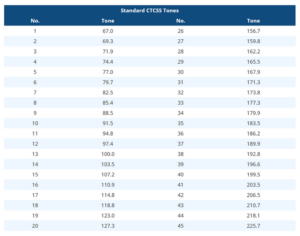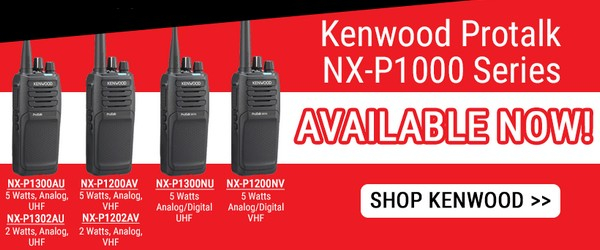
CTCSS is an acronym for Continuous Tone Coded Squelch System. It is a set of sub-audible tones that act as filters to eliminate interference from unwanted transmissions originated by other individuals or groups who are operating on the same channel or frequency. CTCSS tones are also commonly known as Interference Eliminator codes, PL or Private Line codes, QT codes, channel guard, or subchannels.
Some consumer and business radios that support CTCSS tones may assign a number to each tone within the radio menu for selection and programming options. Other radios simply list the tones themselves and allow you to choose them directly.
It is important to understand that there is no universal or industry-wide standard for CTCSS tones or their number assignments in a radio. Also, some radios may only support certain tones and may not support others.
This article covers CTCSS tones only. For DCS codes, please refer to the Chart of Standard DCS codes.
Listed below is a chart of CTCSS tones often used for two way radios, along with common tone number assignments for radios that use them. Again, these tone number assignments are a general guide only and may vary between makes and models of two way radios. Consult the user manual for your radio for the specific tones supported.
Common CTCSS Tones
| Common CTCSS Tones | |||
|---|---|---|---|
| No. | Tone | No. | Tone |
| 1 | 67.0 | 20 | 131.8 |
| 2 | 71.9 | 21 | 136.5 |
| 3 | 74.4 | 22 | 141.3 |
| 4 | 77.0 | 23 | 146.2 |
| 5 | 79.7 | 24 | 151.4 |
| 6 | 82.5 | 25 | 156.7 |
| 7 | 85.4 | 26 | 162.2 |
| 8 | 88.5 | 27 | 167.9 |
| 9 | 91.5 | 28 | 173.8 |
| 10 | 94.8 | 29 | 179.9 |
| 11 | 97.4 | 30 | 186.2 |
| 12 | 100.0 | 31 | 192.8 |
| 13 | 103.5 | 32 | 203.5 |
| 14 | 107.2 | 33 | 210.7 |
| 15 | 110.9 | 34 | 218.1 |
| 16 | 114.8 | 35 | 225.7 |
| 17 | 118.8 | 36 | 233.6 |
| 18 | 123.0 | 37 | 241.8 |
| 19 | 127.3 | 38 | 250.3 |
Some higher end radios support an expanded list of CTCSS tones. Wouxun in particular Includes a set of 50 tones, and a few models support both standard and non-standard tones for even greater flexibility.
The List below is a chart of CTCSS tones that Wouxun typically supports in its line of radios, along with their number assignments.
Wouxun CTCSS Tones
| Wouxun Standard CTCSS Tones | |||
|---|---|---|---|
| No. | Tone | No. | Tone |
| 1 | 67.0 | 26 | 156.7 |
| 2 | 69.3 | 27 | 159.8 |
| 3 | 71.9 | 28 | 162.2 |
| 4 | 74.4 | 29 | 165.5 |
| 5 | 77.0 | 30 | 167.9 |
| 6 | 79.7 | 31 | 171.3 |
| 7 | 82.5 | 32 | 173.8 |
| 8 | 85.4 | 33 | 177.3 |
| 9 | 88.5 | 34 | 179.9 |
| 10 | 91.5 | 35 | 183.5 |
| 11 | 94.8 | 36 | 186.2 |
| 12 | 97.4 | 37 | 189.9 |
| 13 | 100.0 | 38 | 192.8 |
| 14 | 103.5 | 39 | 196.6 |
| 15 | 107.2 | 40 | 199.5 |
| 16 | 110.9 | 41 | 203.5 |
| 17 | 114.8 | 42 | 206.5 |
| 18 | 118.8 | 43 | 210.7 |
| 19 | 123.0 | 44 | 218.1 |
| 20 | 127.3 | 45 | 225.7 |
| 21 | 131.8 | 46 | 229.1 |
| 22 | 136.5 | 47 | 233.6 |
| 23 | 141.3 | 48 | 241.8 |
| 24 | 146.2 | 49 | 250.3 |
| 25 | 151.4 | 50 | 254.1 |







I have a question about this. I understand these 'tones' are supposedly considered to be 'sub-audible,' but I am not sure why.
All of these tones fall within the 'normal' range of human hearing. So, if I'm using an amateur radio repeater that requires a PL tone,
why do I not hear it on the output side of the repeater? Is it just not transmitted through to the output frequency?
Thanks,
Tory G.
The term subaudible refers to tones that are so low that most human ears generally don't hear them. These tones are still received and can be heard by the radio, but can be filtered by the receiver circuitry so they are not output to the radio speaker.
I am looking for a tool to identify CTCSS and DCS tones. I found some older YB-562 Portable LCD Display CTCSS/DCS Decoder products online and a KG-TONE software.
Are you aware of anything newer and avaailable for the iPhone? Is there anything available that can detect the receiving signal and determine the CTCSS or DCS tone?
Thanks,
Blackhawks
Several Wouxun GMRS radios will scan and detect CTCSS tones and DCS codes. These include the KG-905G, KG-935G, KG-935G Plus, KG-1000G, KG-1000G Plus, KG-S88G, and the KG-XS20G Plus.